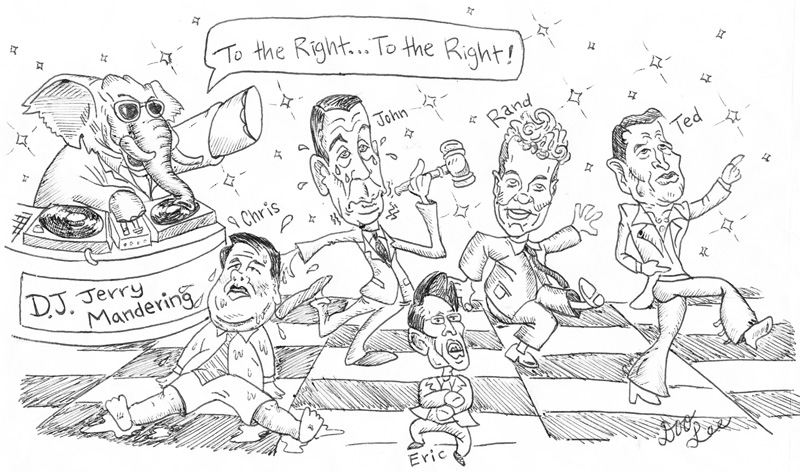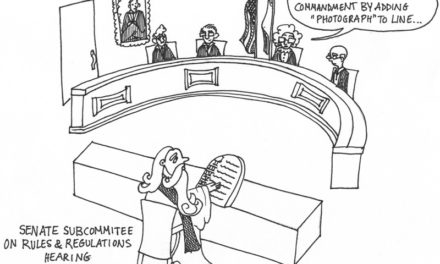If you are hoping for a Democratic (re)takeover of the House of Representatives in 2014, then dream on.
Democrats may have to deal with a divided federal legislature for a long, long time. A GOP-controlled House is likely for 2014, 2016 and 2018.
First, a little background: when Republicans made their stunning sweep in the 2010 midterm election, it provided them the once-in-a-decade opportunity to build and fortify an intrinsic electoral advantage when the 2010 U.S. Census required that districts be redrawn and updated.
Republican-controlled state legislatures and governors carved out safe GOP Congressional seats, crowding in minority-heavy municipalities into single minority-majority districts.
The consequence of this gerrymandering was the disappearance of competitive House races. In 1998, there were 124 pure swing seats, nearly a third of the House.
Today, there are only 47 toss-ups left. The numbers of House seats needed to keep the majority will most likely stay in Republican hands, guaranteeing the GOP control of at least one chamber in Congress for the next eight years.
For future Democrats, however, the Republican ligature may actually be a blessing in disguise. Gerrymandering has so far prevented the Republican Party from going through the necessary party reform and revival. The Party has instead taken sanctuary in the South, particularly in overwhelmingly white, ethnically-homogeneous districts. What was the Republican launchpad for national victories in 2000 and 2004 has become the safety bunker for those in an embattled party.
Yet underneath all those bright red House seats lie trends that could undo the party’s current advantage.
A gerrymandered House is becoming one of the biggest deterrents to a new and revitalized GOP. Many Republicans want to make the necessary party changes, but the comfort and guarantee of a safe House and a hung Congress is sapping the party of the kind of urgency and incentive it needs to make those improvements.
Gerrymandering has essentially anchored the party to a single spectrum of ideology and is tugging the party further towards the right.
This behavior is not all that uncommon. When a political party fails to deliver on its promises, its base has a bad tendency to respond by recoiling to the fringe. Every American party has run to the right or to the left at one point in its lifetime. It is a marathon every partisan knows too well. The most recent occurred in 1968 when liberals within the Democratic Party, frustrated by the conservative mood of the country, angrily lurched to the left. The consequence was a badly divided Democratic Party that only accelerated a national realignment in favor of Republicans.
Conservatives today may well be tempted to do the same – to just vote with their gut and let all else be damned. Yet, if current demographic trends hold, such action could potentially usher a Democratic deluge. Compounding eight years of President Obama is the possibility of eight years of President Hillary Clinton. The Republican Party must tread lightly.
As a purist, arch-conservative mandate spreads its root in an identity troubled GOP, it will become ever harder for Republicans to win over the growing Hispanic and Asian electorate.
It will only become more difficult to change the rhetoric as time goes on. Voting patterns become habits which can then evolve into party affiliations. To stave off a national atrophy, Republican leaders must act while there is still political plasticity.
The writing on the wall is clear. Though gerrymandering will benefit Republicans in the short run, safe below the Mason-Dixon Line, in 10 years, it could cost the party an entire generation of voters.
A myopic view of future political reality and a decision to put short-term gratification over long-term growth has so far trumped the party’s necessity to reform.
At a time when the GOP must move to the middle on some issues, the party is instead dancing to a surreal and stubborn shuffle: to the right, to the right and further to the right.
Doo Lee is a College sophomore from Suwanee, Ga.
Cartoon by Doo Lee
The Emory Wheel was founded in 1919 and is currently the only independent, student-run newspaper of Emory University. The Wheel publishes weekly on Wednesdays during the academic year, except during University holidays and scheduled publication intermissions.
The Wheel is financially and editorially independent from the University. All of its content is generated by the Wheel’s more than 100 student staff members and contributing writers, and its printing costs are covered by profits from self-generated advertising sales.







Perhaps you were not watching when the Texas Legislature successfully redistricted in the middle of the decennial census. They did so immediately after taking control of the body. And, given that it was upheld, any party who takes control of a state legislature may now redraw the lines at ANY time as they see fit. The census only gives those states the guidelines they must use to do it.
The GOP tendency to capture power and then secure it through redrawing of the lines at both the state and federal level nearly guarantees that they will continue to hold more power than their national vote totals would suggest. As an example, the last congressional election in 2012 had more people voting for Congressional candidates of the Democratic party over Republicans. Gerrymandering has permitted the true minority party to continue to hold onto a majority of seats in Congress. In capturing state seats in much the same way, the Republicans ensure that a farm team of candidates with higher name ID rise up to compete for those Congressional seats successfully.
So in conclusion, I find the analysis in the article above based on emotions and not based on actual facts and trends. As one who worked as a political consultant for both Democratic and Republicans House and Senate members, I expect more from an analysis of political trends than this.
@ Maximus Boxer,
Thank you for your feedback. It’s always great fun to argue and learn from others; I still have lots to learn so I welcome your critiques. I would, however, on one, oppose your proposition that this article was based purely on emotions and absent of actual facts. It is a holistic opinion-editorial (not a data-deluged algorithm), and I think you should keep that in mind. My thoughts were not about when/how legislatures are able to gerrymander, but about the contemporary consequences of House gerrymandering on the Republican Party itself, which was the popular election of more-conservative-than-usual, right wing politicians, particularly from the South. It is true that states can redistrict any time they want (as you said) as long as they do it at least once every decade, as established by SCOTUS, but the 2010 Census did obligate the states to redistrict whether they wished to or not, giving the GOP the legislative window and the fresh political momentum from the Tea Party to act. I don’t think it’s fair to accuse only the GOP for gerrymandering when almost all political parties have taken the advantage when available. Such is the nature of the beast. I’m also curious as to where in the writing, you found the piece to be only “based on emotion” for it is a fact that the GOP is moving to the right (as of right now) -> http://xkcd.com/1127/large/
and that such trajectory it is hurting the party among moderates, independents, and minorities -> http://politicalticker.blogs.cnn.com/2012/12/20/cnn-poll-are-gop-policies-too-extreme/?cid=sf_twitter
Your comment, I think, focuses too narrowly on just the second paragraph of the entire article.This is an Op-ed that gave a historical anecdote among many things and my thoughts on its possible applicability for current times – of which I proudly defend. Nonetheless, I appreciate your comments and if possible, would love to read some of your own analyses (as you mentioned, from someone who has actually worked as a political professional to federal politicians).
Personally, I don’t even understand the purpose of gerrymandering when you weigh costs and benefits. Can someone explain to me the problem with having districts written up to contain equal (or close) numbers of voters? Partisan legislatures should not be expected to have the authority to rig elections by drawing up arbitrary districts and be expected not to do it, on both sides.This more proportional distribution of districts could also help with ameliorating the polarization of districts as either strongly red or strongly blue, ending the peer pressure of having to vote red or blue just because everyone else in your toddler’s drawing look-alike district votes one way.
congratulations for the beautiful text
como reconquistar http://www.outrachance.com.br/
Ncis Time of year 8-10 Instance 10: An outstanding Instance Using Frank Newhart